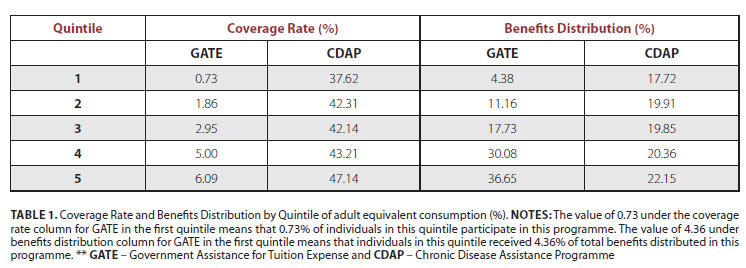 |
 |
 |
|
May 2014
|
Social assistance plays an important role in poverty reduction by mitigating the effects of poverty and other risks faced by vulnerable households (World Bank). It also provides longer-term relief through investments in human capital. Social assistance programmes are publicly funded, non-contributory transfers that help the poor, by increasing their available options and expanding their capabilities to cope with these risks. This study investigated the coverage of the poor in two Social Assistance Programmes in Trinidad and Tobago: the Government Assistance for Tuition Expense or the GATE and the Chronic Disease Assistance Programme or the CDAP. The GATE provides tuition funding for citizens enrolled in approved tertiary education programmes, and the CDAP is a free prescription drug service offered to all citizens with chronic diseases. These programmes attempt to break the cycle of chronic poverty by investing in the educational and health aspects of human capital. Both programmes are universal and are not targeted to any particular income group in the population. This study also identified those characteristics that determine and encourage participation in these social assistance programmes. The data for the analysis undertaken in this study is drawn from the 2008/2009 Trinidad and Tobago Household Budget Survey (HBS), which provides detailed information on the expenditure patterns of private households. The realized sample was 7,090 households that covered all cities, boroughs and regions in Trinidad and Tobago. The participation of the poor in these programmes is evaluated using coverage rate by quintile and quintile distribution of programme benefits. Quintiles divide the population in five equal parts, with each quintile representing 20% of the population. A quintile distribution ranks the quintiles from the lowest to the highest so that the first quintile refers to the poorest 20% and the fifth quintile refers to the wealthiest 20%. In this study quintiles are ranked using adult equivalent expenditure data. Coverage rate by quintile reports the percentage of each quintile that participates in a particular programme, and the distribution of programme benefits reports the distribution of programme benefits received per quintile. Determinants of participation in each programme are estimated using probit models. Participation by an individual in a programme, is given a value of 1 if they participate and a value of 0 if otherwise. The results displayed in Table 1 below, indicate that that the poor are underrepresented in both the GATE and the CDAP programmes. GATE’s coverage at every quintile was low, with the highest coverage being 6% in the wealthiest quintile, with less than 1% of those in the poorest quintile accessing this benefit. The CDAP fared much better with quintile coverage ranging from 38% to 47% from the lowest to highest quintile. However, these results on coverage are moderate at best, with more than half of all individuals with chronic diseases in each quintile being left without coverage. Further, the results on coverage of the GATE and the CDAP reveal that these programmes are regressive, where the poor are less likely to participate than their non-poor counterparts. The results of the distribution by quintile reveal that the benefits of the universal programmes are poorly distributed. Individuals in the poorest quintile receive the smallest amount of benefits in both the GATE and the CDAP programmes and are the least likely to receive benefits, compared to the other quintiles. In regard to the GATE, the top three quintiles received 85% of the benefit and 38% of the CDAP benefit went to the bottom two quintiles. Based on these results, we conclude that the distribution of these universal social assistance benefits is not effectively or consistently reaching the poorest individuals. The probit results indicate that age significantly influences an individual’s likelihood of participating in each programme. The older a person gets, the more likely he or she is to participate in the CDAP and conversely, the probability of participating in the GATE significantly decreases with age. Thus, as people get older a higher level of healthcare is needed and at a younger age more focus is placed on education as a driver for development. The average income area where an individual resides was another contributing factor in his/her decision to access government assistance. Individuals from low and middle-income areas were more likely to participate in the CDAP than those from high-income areas. The sex variable shows that females tend to have a higher probability of participation in the GATE and the CDAP. This can be attributed to the fact that females account for 66% of university enrolment in T&T and that women report more cases of chronic non-communicable diseases and make greater use of health services than males. An investigation into the type of worker variables indicates that working in the public sector or being an apprentice significantly and positively influences participation in the GATE programme than being self-employed. This points to a possible weakness in the system that seems to neglect self-employed or freelance individuals, which should be addressed by policy makers. The results suggest that more effort is required in targeting Trinidad and Tobago’s social assistance programmes, to increase the coverage of the poor. Apart from possibly expanding some of these programmes, it might be necessary to undertake the difficult task of reallocating spending, over time, away from programmes that primarily benefit upper-income groups. Finally, reallocating social spending to programmes that provides most benefit to the poor will also be important for forging a more equitable society. Raynata Wiggins, PhD Student, and Sandra Sookram, Fellow, both of the Sir Arthur Lewis Institute of Social and Economic Studies presented this paper, “The participation of the poor in universal social assistance in Trinidad and Tobago,” at the 15th annual conference of SALISES held from April 23-25, 2014, on the theme, “Caribbean Development: Standing Still or Standing Tall? Theoretical, Empirical and Policy Challenges.” |


